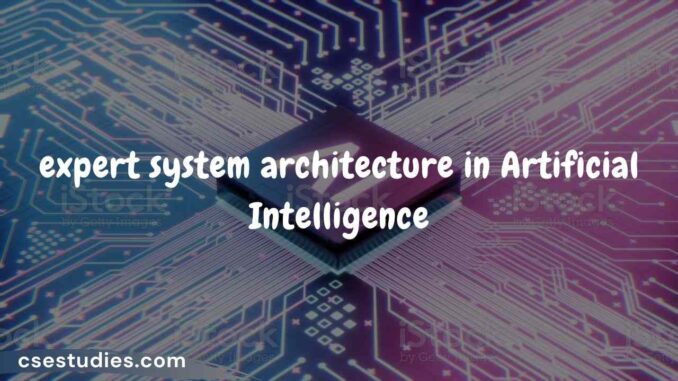
Expert systems typically follow a layered architecture that consists of several components working together to provide intelligent decision-making capabilities. Here is a general overview of the architecture of an expert system:
- User Interface:
- The user interface component allows users to interact with the expert system. It provides a means for users to input their queries, provide information, and receive responses from the system. The interface can be text-based, graphical, or a combination of both, depending on the application and user requirements.
- The user interface component allows users to interact with the expert system. It provides a means for users to input their queries, provide information, and receive responses from the system. The interface can be text-based, graphical, or a combination of both, depending on the application and user requirements.
- Knowledge Base:
- The knowledge base is the core component of an expert system. It contains the domain-specific knowledge and expertise that the system utilizes to provide intelligent responses and recommendations. The knowledge base is typically represented in the form of rules, facts, heuristics, or other knowledge representation methods specific to the domain.
- The knowledge base is the core component of an expert system. It contains the domain-specific knowledge and expertise that the system utilizes to provide intelligent responses and recommendations. The knowledge base is typically represented in the form of rules, facts, heuristics, or other knowledge representation methods specific to the domain.
- Inference Engine:
- The inference engine is responsible for processing the user inputs and applying the knowledge base to generate responses or recommendations. It uses various reasoning techniques, such as forward chaining or backward chaining, to infer conclusions based on the available knowledge. The inference engine applies rules, performs pattern matching, and makes logical deductions to derive the appropriate responses.
- The inference engine is responsible for processing the user inputs and applying the knowledge base to generate responses or recommendations. It uses various reasoning techniques, such as forward chaining or backward chaining, to infer conclusions based on the available knowledge. The inference engine applies rules, performs pattern matching, and makes logical deductions to derive the appropriate responses.
- Explanation Module:
- The explanation module provides explanations for the system’s responses and reasoning. It helps users understand how the system arrived at a particular conclusion or recommendation. The module may provide step-by-step explanations, highlight the relevant rules or facts used, and offer justification for the system’s decisions.
- The explanation module provides explanations for the system’s responses and reasoning. It helps users understand how the system arrived at a particular conclusion or recommendation. The module may provide step-by-step explanations, highlight the relevant rules or facts used, and offer justification for the system’s decisions.
- Knowledge Acquisition:
- The knowledge acquisition component allows for the addition, modification, or deletion of knowledge within the system. It provides a means for domain experts or system administrators to update the knowledge base based on new information, changes in the domain, or user feedback. Knowledge acquisition methods can include interviews with experts, knowledge elicitation techniques, or automated learning algorithms.
- The knowledge acquisition component allows for the addition, modification, or deletion of knowledge within the system. It provides a means for domain experts or system administrators to update the knowledge base based on new information, changes in the domain, or user feedback. Knowledge acquisition methods can include interviews with experts, knowledge elicitation techniques, or automated learning algorithms.
- Validation and Verification:
- The validation and verification module ensures the integrity and reliability of the expert system. It checks the consistency of the knowledge base, verifies the correctness of rules and facts, and performs quality control measures to ensure that the system produces accurate and reliable results. Validation techniques can include testing, benchmarking, and comparison with known expert judgments.
- The validation and verification module ensures the integrity and reliability of the expert system. It checks the consistency of the knowledge base, verifies the correctness of rules and facts, and performs quality control measures to ensure that the system produces accurate and reliable results. Validation techniques can include testing, benchmarking, and comparison with known expert judgments.
- Knowledge Base Editor:
- The knowledge base editor provides a tool for editing, organizing, and managing the knowledge base. It allows administrators or domain experts to create, modify, or delete rules, facts, and other components of the knowledge base. The editor may provide features such as syntax checking, version control, and search functionalities to facilitate efficient knowledge management.
- The knowledge base editor provides a tool for editing, organizing, and managing the knowledge base. It allows administrators or domain experts to create, modify, or delete rules, facts, and other components of the knowledge base. The editor may provide features such as syntax checking, version control, and search functionalities to facilitate efficient knowledge management.
- Domain Interface:
- The domain interface allows the expert system to communicate with external systems or databases that provide domain-specific data or resources. It enables the expert system to retrieve relevant information, update external databases, or integrate with other applications or services to enhance its decision-making capabilities.
The architecture of an expert system can vary depending on the specific requirements and complexity of the domain. Different expert systems may incorporate additional components or modules tailored to their unique needs. However, the fundamental components described above form the core structure of an expert system, enabling the capture, representation, and application of domain expertise to support intelligent decision-making.